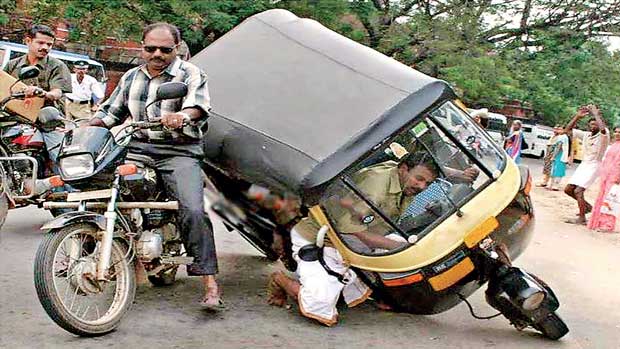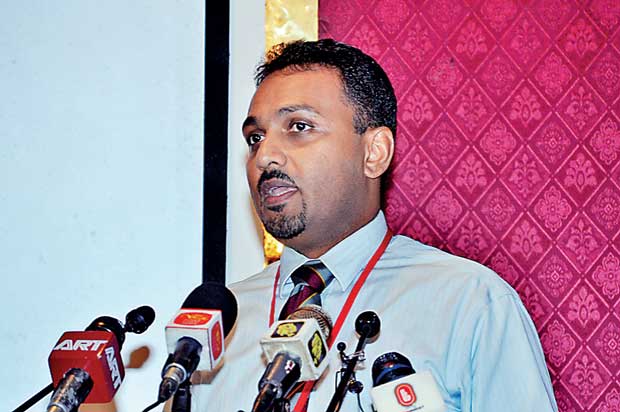Reply To:
Name - Reply Comment
Last Updated : 2024-04-18 06:32:00
The origins of road traffic accidents can be traced back to the time of the invention of the first patented automobile by Carl Benz in the 17th century, or may go back even further, if the accidents in the regency times caused by horse-drawn carriages are taken into account.
 Motorcycles and three wheelers a involved in the worst accidents
Motorcycles and three wheelers a involved in the worst accidents
At present, about 1.25 million people die each year as a result of road accidents according to WHO statistics. Road traffic injuries are the leading cause of death for people aged between 15 and 29 years worldwide. Talking about the situation in Sri Lankan, after witnessing at least a few accidents- where there are horrifying images relating to them in the media- or by getting involved in accidents ourselves, most of us have become intimately familiar with the topic.
 But did you know that Road Traffic Accidents claim an average of eight lives per day, going up to three thousand lives per year in our country? Did you know that a significant portion of these deaths relates to young men who are a part of the country’s working force? Did you also know that their deaths have significantly affected the country’s economy in addition to the loss their loved ones feel?
But did you know that Road Traffic Accidents claim an average of eight lives per day, going up to three thousand lives per year in our country? Did you know that a significant portion of these deaths relates to young men who are a part of the country’s working force? Did you also know that their deaths have significantly affected the country’s economy in addition to the loss their loved ones feel?
They have formulated the theory that three wheelers and motorcycles are more prone to crashes because they are the most unstable when it comes to vehicles, and topple easily
These facts were revealed at a press conference held as a prequel to the workshop ‘Road Traffic Crashes: How do we save lives?’ held at the Sri Lanka Medical Association Premises as a preliminary programme to the SLMA annual Sessions.
 Dr Achala Jayatilake
Dr Achala Jayatilake
Professor Samath Dharmarathne of the Faculty of Medicine, Peradeniya, speaking on the topic of Road Traffic Accidents (RTA) stated that in Sri Lanka, while three to four people are admitted to the hospital every hour due to injuries from RTA’s, a new accident is reported at least once in every ten minutes.
Figures obtained from the Ministry of Transport and Aviation website reveal that out of the 2824 fatal accidents occurred last year, a majority of 1227 were motorcycle accidents. 405 of the total number of accidents involved three wheelers. We investigated in to the reason behind the increase of fatal accidents regarding these two types of vehicles. Dr Samath and his fellow researchers have discussed this issue in their paper titled ‘Road traffic crashes, injury and fatality trends in Sri Lanka: 1938–2013’. They have formulated the theory that three wheelers and motorcycles are more prone to crashes because they are the most unstable when it comes to vehicles, and topple easily. Since two and three-wheeled vehicles are less robust than other vehicles and don’t offer passengers a safe enclosure nor the protection of seat belts, occupants are more likely to be injured in a crash.
According to worldwide data, 90% of the world’s fatalities on the roads occur in low- and middle-income countries, even though these countries have approximately 54% of the world’s vehicles. WHO list the risk factors for increased road traffic accidents, which involves among others, speeding, driving under the influence of alcohol or other psychoactive substances, Non-use of motorcycle helmets, seat-belts, and child restraints, unsafe road infrastructure, inadequate law enforcement of traffic laws, which may all factor in the increased fatalities in low and middle income countries like Sri Lanka.
Considering the situation in Sri Lanka, the after effects of a road traffic injury were also discussed at the conference. According to Dr Achala Jayathilake, Senior Lecturer of the Post Graduate Institute of Medicine, more than 50% of the citizens who are involved in RTAs are from low income families. Around 1/3rd of the injured are pedestrians, who sometimes have never owned a vehicle in their lives. The majority of the fatal accidents involves males who are in the prime of their youth.
In the case of a road traffic injury, in addition to the direct financial burden on the family in the form of medical expenses, a less visible, nevertheless considerable, loss also occurs. The debilitation of a working individual causes loss of productivity, especially if he is the breadwinner. The family then suffers a major financial setback. The cost incurred due to the family members taking time off work to care for the injured also can’t be ignored. All these expenses add up to a considerable amount of money and resources. This ultimately burdens the society as a whole. This burden has been steadily increasing over the years as is evident from the fact that the incidents of road traffic crashes increased markedly from 61.2 per 100 000 population in 1938 to 183.6 per 100 000 in 2013 as per the above mentioned research, published in the WHO website. In the last year alone, nearly 10 million rupees have been spent by the government as compensation for RTAs, though the expenses borne are much higher than this.
When observing the ever increasing numbers of RTAs and fatalities over the years, we know that the number of vehicles that’ll hit the road are only going to increase each day for the foreseeable future. This puts us in a hopeless situation. But this doesn’t have to be so, according to the specialists in the field. “The most crucial thing that should be noted when talking about road traffic accidents is that the majority of these deaths, the injuries and the accidents themselves are preventable”, commented Dr. Jayathilake.
When talking about preventative measures taken with regards to RTAs and the reduction of the fatalities count, the World Report on Road Traffic Injury Prevention, published by the WHO, suggests a number of improvements.
Good transport and land-use policies as well as safety-conscious planning and the design of a road network will pave the path towards the reduction of accidents, caused other than through human error. This is relevant to countries like Sri Lanka whose road system needs improvement.
Compliance with key road safety rules can be significantly increased using a combination of legislation, enforcement of the laws, and information and education. “Though we can’t prevent the occurrence of Diabetes by bringing forth a law that says a person can’t use more than 6 spoonfuls of sugar a day, we can bring laws to establish a speed limit and to ensure road safety. Japan has drastically reduced it’s RTAs through the implementation of strict laws. For an example, in the case of an accident involving a drunk driver, the owner of the restaurant that sold the driver alcohol is also fined in addition to the driver. The fine is significant, so a person rarely drives while being drunk,” commented Dr. Jayathilake, speaking about the traffic laws. He further stated that we should follow the example of developed countries like Japan and Sweden and increase the penalties when traffic laws are violated. “Drunk driving should definitely bring heavy penalties. This is because when occupying the driving seat while being intoxicated, a driver is fully aware that he or she is exposing other innocent lives to danger. This is equal to murder,” he further remarked.
When the prevention of an accident fails, our next main concern should be on preventing fatalities and minimizing the injuries. Crash-protective features of a vehicle can save lives and reduce injuries of those who use the road- both inside and outside the vehicle. WHO states that wearing a motorcycle helmet properly can reduce the risk of death by almost 40% and also cut the risk of severe injury by over 70%. Similarly, wearing a seat-belt reduces the risk of a fatality among front-seat passengers by 40–50%. The proper use of seat-belts will also reduce the fatality risk of rear-seat passengers by 25–75%. Child restraints reduce deaths among infants by approximately 70% and deaths among small children by between 54% and 80%.
WHO states that wearing a motorcycle helmet properly can reduce the risk of death by almost 40% and also cut the risk of severe injury by over 70%.
The availability of good quality emergency care can save lives, and greatly reduce the severity and long-term consequences of road injuries. The country’s emergency care needs to progress, bestowing special attention on improving the emergency medical staff and equipment. In addition, giving basic first aid training to the general public is also crucial because the outcome of the patient greatly depends on the care he receives during the first few minutes immediately following an accident.
As is evident from the above paragraphs, the prevention of road traffic accidents is a complicated as well as a multifaceted procedure, which can’t be undertaken by a single organization. Focusing on mapping an effective plan on RTA prevention was the main focus of the seminar.
The two speakers were of the opinion that despite the numerous interventions done by various ministries and organizations, there are no visible improvements in the statistics. The increase in the incidence of road traffic accidents over the years, coming up to three times that of the incidence of 1938 bears further proof to their statement. But as they stated, the main cause for this isn’t the lack of taking action.
“Even though every ministry has taken measures to make the road a safe place, we see a lack of co-ordination among these ministries and organizations,” commented Prof. Samath. He further stated that the RTAs of the country would be significantly reduced if the ministries like the Health Ministry, Education Ministry, The Ministry of Transportation and Ministry of Highways would unify under one action plan, while performing their individual duties.
Compliance with key road safety rules can be significantly increased using a combination of legislation, enforcement of the laws, and information and education.
Speaking about the measures that can be taken to improve the outcome, Dr. Jayathilake stressed on the need for implementing a special presidential task force to prevent RTIs. “The advantage of a presidential task force is that all the ministries, who were working separately until now will sit on one table, where they can develop a contingency plan that is sustainable, enabling them to continue their work in their individual fields, but which will ultimately result in a better, collective outcome,” he concluded.
PIX BY NISAL BADUGE

Add comment
Comments will be edited (grammar, spelling and slang) and authorized at the discretion of Daily Mirror online. The website also has the right not to publish selected comments.
Reply To:
Name - Reply Comment
On March 26, a couple arriving from Thailand was arrested with 88 live animal
According to villagers from Naula-Moragolla out of 105 families 80 can afford
Is the situation in Sri Lanka so grim that locals harbour hope that they coul
A recent post on social media revealed that three purple-faced langurs near t

10 Apr 2024
09 Apr 2024